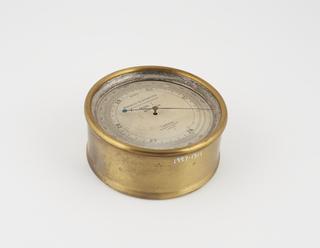
Callender sunshine recorder by Cambridge Instruments
Callender sunshine recorder by Cambridge Instruments, 1913
This form of electrical sunshine recorder was devised by Professor H. L. Callender in 1900 and operated with his Callender Recorder which employed a modification of the Wheatstone Bridge.
The instrument is essentially a differential platinum thermometer consisting of two resistance coils, one black and the other bright, which form the two arms of a Wheatstone Bridge. The blackened coils absorb heat while the bright ones do not. In practice the instrument was connected to the recorder which gave a continuous trace of the net output. The instruments were individually calibrated and given a factor by means of which the total amount of heat actually received could be calculated and expressed centimeter per second.
Details
- Category:
- Meteorology
- Object Number:
- 1995-821
- Measurements:
-
overall: 19.8 x 11 cm
- credit:
- Meteorological Office, Berkshire




